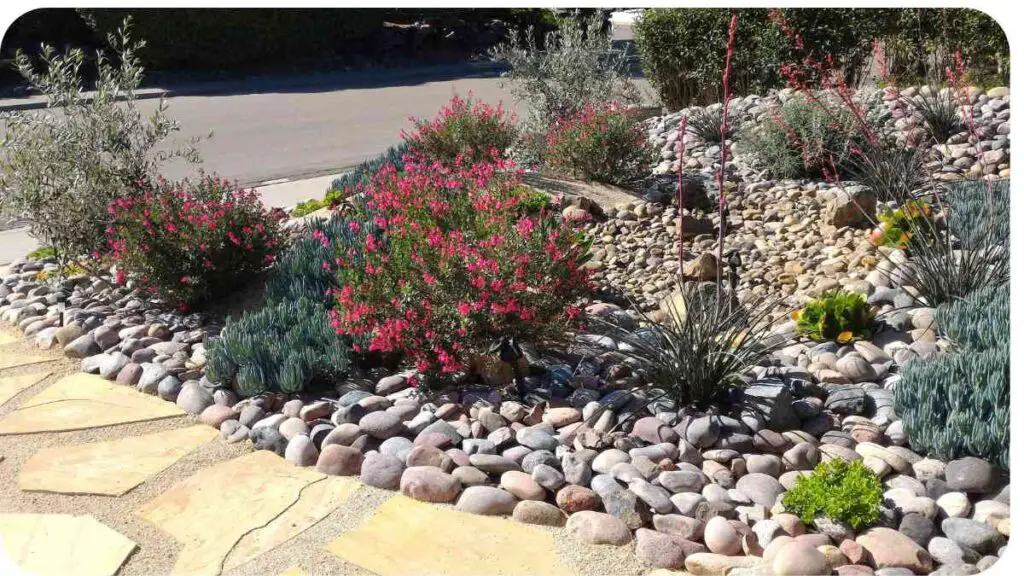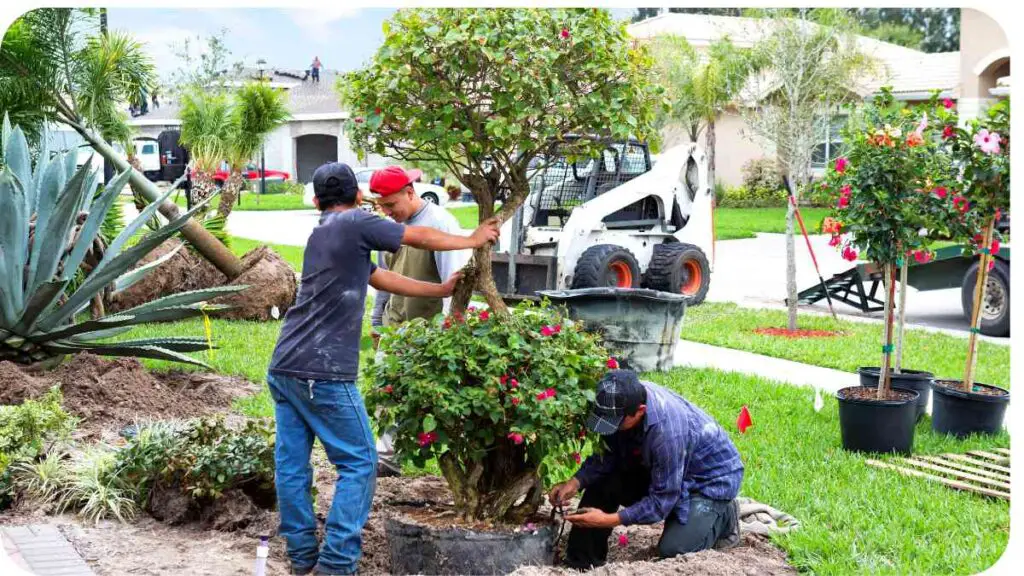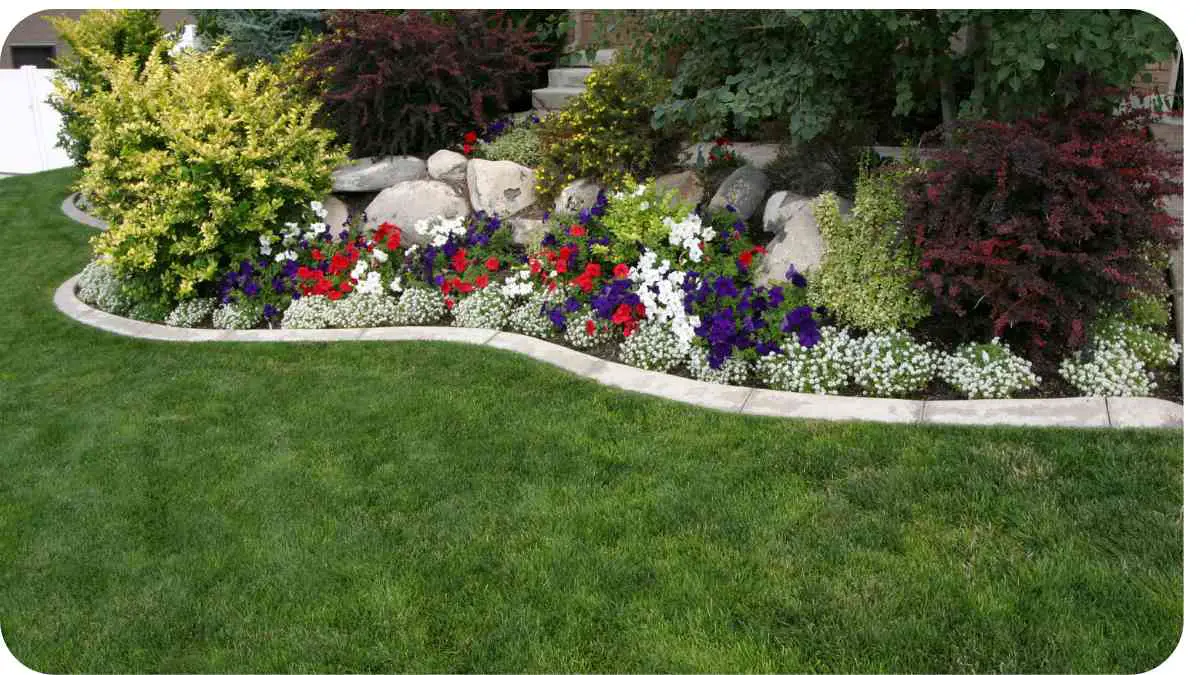As the world grapples with the challenges of climate change, water conservation has become a critical aspect of responsible landscaping. A drought-resistant front yard is not only an eco-friendly choice but also a cost-effective and low-maintenance option.
In this article, we’ll explore the ins and outs of building a drought-resistant front yard, from understanding drought-resistant plants to designing a water-efficient landscape.
| Takeaway |
|---|
| Assess your yard’s conditions, including soil type and moisture levels, to determine the best drought-resistant plants and design principles for your yard. |
| Choose drought-resistant plants that are adapted to your local climate and soil type, and that require minimal watering and maintenance. |
| Use efficient irrigation systems, such as drip irrigation and smart irrigation controllers, to reduce water waste and optimize water usage. |
| Incorporate mulch and groundcovers to retain soil moisture, suppress weeds, and reduce water evaporation. |
| Design a water-efficient landscape that minimizes water usage and reduces maintenance. |
| Consider using lawn alternatives, such as succulents and cacti, to reduce water usage and create a unique outdoor space. |
| Regularly maintain and upkeep your drought-resistant front yard to ensure its success. |
What is a Drought-Resistant Front Yard?

A drought-resistant front yard is a type of landscaping that uses plants, materials, and design principles to minimize water usage. This type of yard is designed to thrive in areas with low rainfall or water restrictions, making it an ideal choice for homeowners in regions prone to drought.
Looking to create a drought-resistant front yard? Explore ideas for outdoor enjoyment to make the most of your space while conserving water and maintaining beauty.
Importance of Drought-Resistant Landscaping
Drought-resistant landscaping is crucial for several reasons:
- Water conservation: Drought-resistant landscaping helps reduce water usage, which is essential in areas where water is scarce.
- Cost savings: By using drought-resistant plants and efficient irrigation systems, homeowners can save money on water bills.
- Low maintenance: Drought-resistant landscaping requires less maintenance, as plants are adapted to survive with minimal watering.
- Environmental benefits: Drought-resistant landscaping helps reduce the carbon footprint of homeowners and promotes a more sustainable environment.
Understanding Drought-Resistant Plants
Drought-resistant plants are the backbone of a drought-resistant front yard. These plants have adapted to survive in areas with low rainfall, making them ideal for water-conscious landscaping.
Characteristics of Drought-Resistant Plants
Drought-resistant plants typically have the following characteristics:
- Deep roots to access water deep in the soil
- Small leaves or waxy coatings to reduce water loss
- Drought-tolerant seeds that can survive for extended periods without water
- Ability to go dormant during periods of drought
Transform your sloping front yard into a masterpiece with tips for landscaping. Learn how to tackle challenges and create a beautiful, drought-resistant landscape.
Examples of Drought-Resistant Plants
Some popular drought-resistant plants include:
- Succulents (e.g., aloe, agave, echeveria)
- Cacti (e.g., prickly pear, Texas star)
- Drought-tolerant grasses (e.g., buffalo grass, blue grama)
- Mediterranean herbs (e.g., rosemary, thyme, lavender)
Table: Drought-Resistant Plants for Different Climates
| Climate | Drought-Resistant Plants |
|---|---|
| Desert | Succulents, cacti, desert willow |
| Mediterranean | Mediterranean herbs, olive trees, lavender |
| Temperate | Drought-tolerant grasses, coneflowers, black-eyed susans |
Assessing Your Yard’s Conditions

Before designing a drought-resistant front yard, it’s essential to assess your yard’s conditions. This will help you determine the best plants, materials, and design principles for your specific climate and soil type.
Evaluating Soil Type and Moisture Levels
Soil type and moisture levels play a crucial role in determining the best drought-resistant plants and design principles for your yard. Here are some factors to consider:
- Soil type: Is your soil sandy, clay-based, or loamy? Different soil types have different water retention capabilities.
- Moisture levels: How much rainfall does your area receive? Are there any areas of high water usage in your yard?
Curious about what you can build in your front yard? Check out building a driveway guide for insights into front yard construction.
Table: Soil Types and Their Water Retention Capabilities
| Soil Type | Water Retention Capability |
|---|---|
| Sandy | Low |
| Clay-based | High |
| Loamy | Medium |
Identifying Areas of High Water Usage
Identify areas of high water usage in your yard, such as:
- Lawns: Lawns require more water than other plants, especially during hot summer months.
- Vegetable gardens: Vegetable gardens require regular watering, especially during fruiting stages.
- Pools and fountains: Pools and fountains can significantly increase water usage in your yard.
Designing a Drought-Resistant Front Yard
Now that you’ve assessed your yard’s conditions, it’s time to design a drought-resistant front yard. Here are some design principles to consider:
- Xeriscaping: Xeriscaping is a type of landscaping that uses drought-resistant plants, efficient irrigation systems, and mulch to minimize water usage.
- Water-efficient design: Design your yard to minimize water usage, such as using rainwater harvesting systems and efficient irrigation systems.
Table: Xeriscaping Principles for a Drought-Resistant Front Yard
| Principle | Description |
|---|---|
| Plan and design | Plan your yard to minimize water usage and use drought-resistant plants. |
| Soil improvement | Improve soil structure and water retention capabilities using organic matter and mulch. |
| Efficient irrigation | Use efficient irrigation systems, such as drip irrigation and rain sensors. |
| Mulch and groundcovers | Use mulch and groundcovers to reduce water evaporation and retain soil moisture. |
| Limited turf areas | Limit lawn areas to reduce water usage and maintenance. |
| Drought-resistant plants | Use drought-resistant plants that are adapted to your local climate. |
Choosing the Right Materials
Choosing the right materials for your drought-resistant front yard is crucial to its success. Here are some materials to consider:
Maintain your garden features for optimal performance with DIY fountain maintenance tips. Keep your outdoor space beautiful and functional with these useful suggestions.
Mulch and Its Benefits
Mulch is a crucial component of a drought-resistant front yard. It helps to:
- Reduce water evaporation: Mulch reduces water evaporation from the soil, retaining soil moisture for longer periods.
- Suppress weeds: Mulch suppresses weed growth, reducing competition for water and nutrients.
- Regulate soil temperature: Mulch regulates soil temperature, keeping it cooler in the summer and warmer in the winter.
Types of Mulch for Drought-Resistant Landscaping

Here are some popular types of mulch for drought-resistant landscaping:
- Organic mulch: Organic mulch, such as wood chips, bark, and leaves, breaks down over time, adding nutrients to the soil.
- Inorganic mulch: Inorganic mulch, such as gravel, stone, and decomposed granite, does not break down over time and requires less maintenance.
Table: Mulch Types and Their Benefits
| Mulch Type | Benefits |
|---|---|
| Organic mulch | Reduces water evaporation, suppresses weeds, regulates soil temperature, adds nutrients to the soil |
| Inorganic mulch | Reduces water evaporation, suppresses weeds, regulates soil temperature, requires less maintenance |
Water Conservation Strategies
Water conservation is a critical aspect of drought-resistant landscaping. Here are some water conservation strategies to consider:
- Rainwater harvesting systems: Rainwater harvesting systems collect and store rainwater for irrigation, reducing municipal water usage.
- Efficient irrigation systems: Efficient irrigation systems, such as drip irrigation and smart irrigation controllers, reduce water waste and optimize water usage.
Table: Water Conservation Strategies for a Drought-Resistant Front Yard
| Strategy | Description |
|---|---|
| Rainwater harvesting systems | Collect and store rainwater for irrigation, reducing municipal water usage. |
| Efficient irrigation systems | Use efficient irrigation systems, such as drip irrigation and smart irrigation controllers, to reduce water waste and optimize water usage. |
| Drought-resistant plants | Use drought-resistant plants that require minimal watering, reducing water usage and maintenance. |
Lawn Alternatives
Traditional lawns can be a significant water guzzler in a drought-resistant front yard. Here are some lawn alternatives to consider:
Ensure your plants stay healthy in your drought-resistant yard. Learn about identifying and treating fungal diseases to keep your garden thriving and resilient.
Low-Water Grasses and Groundcovers
Low-water grasses and groundcovers are a great alternative to traditional lawns. They require minimal watering and maintenance, making them an ideal choice for drought-resistant landscaping.
- Buffalo grass: Buffalo grass is a low-water grass that requires minimal watering and maintenance.
- Blue grama: Blue grama is a low-water grass that is native to North America and requires minimal watering and maintenance.
- Creeping thyme: Creeping thyme is a low-water groundcover that can be used as a lawn alternative.
Succulent and Cacti Lawns
Succulent and cacti lawns are a unique and water-efficient alternative to traditional lawns. They require minimal watering and maintenance, making them an ideal choice for drought-resistant landscaping.
- Succulent lawns: Succulent lawns are made up of a variety of succulent species, such as aloe, agave, and echeveria.
- Cacti lawns: Cacti lawns are made up of a variety of cacti species, such as prickly pear, Texas star, and opuntia.
Table: Lawn Alternatives for a Drought-Resistant Front Yard
| Lawn Alternative | Description |
|---|---|
| Low-water grasses | Buffalo grass, blue grama, and other low-water grasses that require minimal watering and maintenance. |
| Groundcovers | Creeping thyme, sedum, and other groundcovers that require minimal watering and maintenance. |
| Succulent lawns | Succulent lawns made up of a variety of succulent species, such as aloe, agave, and echeveria. |
| Cacti lawns | Cacti lawns made up of a variety of cacti species, such as prickly pear, Texas star, and opuntia. |
Hardscaping and Decor
Hardscaping and decor can add a touch of elegance to your drought-resistant front yard. Here are some hardscaping and decor ideas to consider:
- Drought-resistant hardscaping materials: Use drought-resistant hardscaping materials, such as stone, gravel, and decomposed granite, to reduce water usage and maintenance.
- Decorative elements: Add decorative elements, such as outdoor furniture, planters, and sculptures, to create a visually appealing space.
Table: Drought-Resistant Hardscaping Materials
| Material | Description |
|---|---|
| Stone | A drought-resistant hardscaping material that requires minimal maintenance. |
| Gravel | A drought-resistant hardscaping material that allows for drainage and reduces water usage. |
| Decomposed granite | A drought-resistant hardscaping material that allows for drainage and reduces water usage. |
Maintenance and Upkeep
Maintaining and upkeeping your drought-resistant front yard is crucial to its success. Here are some tips to keep in mind:
Watering Schedules and Techniques
- Water deeply but infrequently: Water your plants deeply but infrequently to encourage deep root growth and reduce water waste.
- Use efficient irrigation systems: Use efficient irrigation systems, such as drip irrigation and smart irrigation controllers, to reduce water waste and optimize water usage.
Pruning and Fertilizing Drought-Resistant Plants
- Prune regularly: Prune your drought-resistant plants regularly to promote healthy growth and reduce water usage.
- Fertilize sparingly: Fertilize your drought-resistant plants sparingly, as they require minimal nutrients to thrive.
Table: Maintenance Schedule for a Drought-Resistant Front Yard
| Task | Frequency |
|---|---|
| Watering | Weekly, but only during periods of drought |
| Pruning | Monthly, to promote healthy growth and reduce water usage |
| Fertilizing | Quarterly, to provide minimal nutrients for growth |
| Mulching | Annually, to retain soil moisture and suppress weeds |
Challenges and Solutions
Every drought-resistant front yard will face challenges, but with the right solutions, you can overcome them. Here are some common challenges and solutions:
Common Challenges
- Pests and diseases: Pests and diseases can be a challenge in a drought-resistant front yard.
- Weeds: Weeds can be a challenge in a drought-resistant front yard, especially during periods of drought.
Solutions
- Use organic pest control methods: Use organic pest control methods, such as neem oil and insecticidal soap, to control pests and diseases.
- Use mulch and groundcovers: Use mulch and groundcovers to suppress weeds and retain soil moisture.
Table: Common Challenges and Solutions in Drought-Resistant Landscaping
| Challenge | Solution |
|---|---|
| Pests and diseases | Use organic pest control methods, such as neem oil and insecticidal soap. |
| Weeds | Use mulch and groundcovers to suppress weeds and retain soil moisture. |
Conclusion
Building a drought-resistant front yard is a great way to conserve water, reduce maintenance, and create a beautiful outdoor space. By following the tips and guidelines outlined in this article, you can create a drought-resistant front yard that is both functional and aesthetically pleasing.
Recap of Key Takeaways
- Assess your yard’s conditions: Assess your yard’s conditions, including soil type, moisture levels, and areas of high water usage.
- Choose drought-resistant plants: Choose drought-resistant plants that are adapted to your local climate and soil type.
- Use efficient irrigation systems: Use efficient irrigation systems, such as drip irrigation and smart irrigation controllers, to reduce water waste and optimize water usage.
- Mulch and groundcovers: Use mulch and groundcovers to retain soil moisture, suppress weeds, and reduce water evaporation.
- Maintain and upkeep: Maintain and upkeep your drought-resistant front yard regularly to ensure its success.
Final Tips
- Be patient: Building a drought-resistant front yard takes time and patience. Don’t be discouraged if it takes a few months for your plants to establish themselves.
- Monitor and adjust: Monitor your drought-resistant front yard regularly and adjust your maintenance and upkeep schedule as needed.
- Enjoy the benefits: Enjoy the benefits of a drought-resistant front yard, including reduced water usage, lower maintenance, and a beautiful outdoor space.
By following these tips and guidelines, you can create a drought-resistant front yard that is both functional and aesthetically pleasing. Remember to be patient, monitor and adjust, and enjoy the benefits of a drought-resistant front yard.
Further Reading
- Design a Drought-Tolerant Yard – Get expert tips and ideas on designing a drought-tolerant yard that’s both beautiful and sustainable.
- Drought-Tolerant Landscaping – Learn about the benefits and principles of drought-tolerant landscaping, and how to create a stunning outdoor space that’s low on water usage.
- Converting Lawn to Drought-Tolerant Front Yard – Follow this step-by-step guide to convert your lawn into a drought-tolerant front yard that’s perfect for water-conscious homeowners.
FAQs
What is drought-tolerant landscaping?
Drought-tolerant landscaping is a type of landscaping that uses plants, materials, and design principles to minimize water usage and create a sustainable outdoor space.
What are the benefits of drought-tolerant landscaping?
The benefits of drought-tolerant landscaping include reduced water consumption, lower maintenance, and a more sustainable outdoor space that’s perfect for water-conscious homeowners.
How do I choose the right drought-tolerant plants for my yard?
Choose drought-tolerant plants that are adapted to your local climate and soil type, and that require minimal watering and maintenance.
What are some design principles for drought-tolerant landscaping?
Some design principles for drought-tolerant landscaping include using efficient irrigation systems, incorporating mulch and groundcovers, and creating a water-efficient landscape design.
Can I still have a beautiful outdoor space with drought-tolerant landscaping?
Yes, drought-tolerant landscaping can be just as beautiful and visually appealing as traditional landscaping, with the added benefits of reduced water usage and lower maintenance.

Hi! My name is Hellen James, and I’m here to help you with your home-maintenance needs. Whether it’s building a better yard or just trying to fix a garden—I can show you how.


